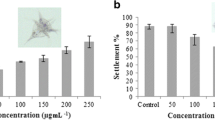Abstract
The bottom food search (BFS) feeding behavior in cod (Gadus morhua L.), has been used in a bioassay for chemical isolation of the feeding stimulant substances present in shrimp (Pandalus borealis). An aqueous methanol extract of ground shrimp was separated into acidic, neutral, and amphoteric/basic fractions by ion-exchange chromatography and into single components by preparative high-pressure liquid chromatography (HPLC). Of the isolated single components, the amino acid glycine was most potent, followed by alanine. Two unidentified substances were also highly potent. There was a synergistic effect between glycine, alanine, proline, and arginine. These four amino acids were more potent than the total amino acid pool found in the shrimp extract, indicating that there may be amino acids in this pool having an antagonistic effect.
Similar content being viewed by others
References
Abe, S., andKaneda, T. 1975. Studies on the effect of marine products on cholesterol metabolism in rats. X. Isolation of β-homobetaine from oyster and betaine contents in oyster and scallop.Bull. Jpn. Soc. Sci. Fish. 41(4):467–471.
Ackman, R.G., andDale, J. 1965. Reactor for Determination of dimethyl-β-propiothetin in tissue of marine origin by gas-liquid chromatography.J. Fish. Res. Board Can. 22(4): 875–883.
Ackman, R.G., Hingley, J., andMay, A.W. 1967. Dimethyl sulflde in Labrador cod.J. Fish. Res. Board Can. 24(2):457–461.
Ackman, R.G., Tocher, C. S., Mclachlan, T. 1966. Dimethyl-β-propiothetin. Determination by reactor gas-liquid chromatography, occurrence in algae and implication on fisheries, pp. 235–242,in Proc. V Int. Seaweed Symp., G. E. Young and J. L. McLaughlan (eds.), Pergamon Press, New York.
Brawn, V.M. 1961. Aggressive behavior in the cod (Gadus callarias L.)Behavior 18:107–147.
Brawn, V.M. 1969. Feeding behavior of cod (Gadus morhua).J. Fish. Res. Board. Can. 26(3):583–596.
Challenger, F. 1959. Aspects of the Organic Chemistry of Sulfur. Butterworths Scientific Publications, London.
Conway, E.J., andByrne, A. 1933. An absorption apparatus for the microdetermination of certain volatile substances. I. The micro determination of ammonia.Biochem. J. 27:419–421.
Døving, K.B., andSelset, R. 1980. Behavior patterns in cod released by electrical stimulation of olfactory tract bundlets.Science 207:559–560.
Granroth, B., andHuttula, T. 1976. Formation of dimethyl sulfide by brakish water and possible implication for the flavor of baltic herring.Finn. Chem. Lett. 6:148–150.
Hayashi, T., Yamaguchi, K., andKonosu, S. 1978. Studies on flavor components in boiled crabs. II. Nucleotids and organic bases in the extracts.Bull. Jpn. Soc. Sci. Fish. 44(12): 1357–1362.
Hjorth-Hansen, S. 1952. Méthode pour le dosage de Lóxyde de triméthylamine.Anal. Chim. Acta 6:438–441.
Ishida, Y. 1968. Physiological studies on evolution of dimethyl sulfide from unicellular marine algae.Mem. Coll. Agric. Kyoto Univ. 94:47–82.
Johnstone, A.D.F. 1980. The detection of dissolved amino acids by the Atlantic cod,Gadus morhua L.J. Fish Biol. 17:219–230.
Konosu, S., andHayashi, T. 1975. Determination of β-alanine betaine and glycine betaine in some marine invertebrates.Bull. Jpn. Soc. Sci. Fish. 41(7):743–746.
Larher, F., Hamelin, J., andStewart, G.R. 1977. L' acide diméthylsulfonium-3 propanoïque de spartina anglica.Phytochemestry 16:2019–2020.
Mackie, A.M., Adron, J.W., andGrant, P.T. 1980. Chemical nature of feeding stimulants for the juvenile Dover sole,Solea solea (L.).J. Fish Biol. 16:701–708.
Noda, H., andHoriguchi, Y. 1975. Studies on the flavor substances of “Nori”, the driedLaver porphra tenera. I. Dimethyl sulfide and dimethyl-β-propiothetin.Bull. Jpn. Soc. Sci. Fish. 41(4):481–486.
Pavlov, J.P. 1927. Conditioned Reflexes. Oxford University Press, London.
Pawson, M.G. 1977. Analysis of a natural chemical attractant for whiting (Merlangus merlangus L.) and cod (Gadus morhua L.) using a behavioral bioassay.Comp. Biochem. Physiol. 56A:129–135.
Tilseth, S., andSolemdal, P. 1977. Methods for testing smell response in fish.Int. Con. Explor. Sea Gear Behav. Commission, B45.
Tokunaga, T., Iida, H., andNakamura, K. 1977. Formation of dimethyl sulfide in antarctic krill, Euphausia superba.Bull. Jpn. Soc. Sci. Fish. 43(10):1209–1217.
Author information
Authors and Affiliations
Rights and permissions
About this article
Cite this article
Ellingsen, O.F., Døving, K.B. Chemical fractionation of shrimp extracts inducing bottom food search behavior in cod (Gadus morhua L.). J Chem Ecol 12, 155–168 (1986). https://doi.org/10.1007/BF01045599
Received:
Accepted:
Issue Date:
DOI: https://doi.org/10.1007/BF01045599




